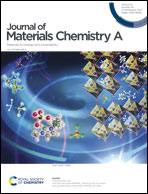Lattice distortion derived catalytic degradation in multi-oxide cathode catalyst for Li–oxygen batteries†
Abstract
Lithium–oxygen batteries (LOBs) are a promising candidate for future power storage, whose performance is critically dependent on the cathode catalyst. The catalytic activity is influenced by the crystal structure, electronic states, surface condition and functional microstructure to a great extent. In the present work, the effect of lattice distortion on the catalytic activity was experimentally and theoretically investigated. Wolframite structured CoWO4 containing Co–O and distorted W–O octahedral frameworks was selected as the cathode catalyst for LOBs. The CoWO4 catalyst with high crystallinity and Co concentrated surface condition exhibited the best performance. Density functional theory (DFT) calculations demonstrated that the distorted [WO6] octahedron degrades the catalytic performance of CoWO4 wolframite catalyst, which causes the degradation of electron transfer efficiency and leads to high adsorption energy of adsorbates for the inefficiency of decomposition of the discharge product. This work provides an insight to understand the influence of lattice distortion and crystal structure on the catalytic capability of multi-oxide cathode catalysts in LOBs.



 Please wait while we load your content...
Please wait while we load your content...